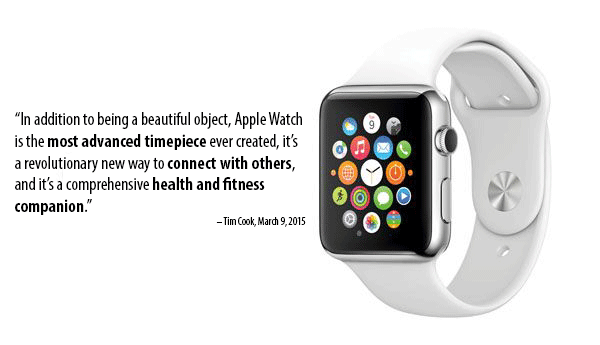One day in early September, almost a week before Apple’s launch event, I was surprised to see a post cross my newsfeed. “My FitBit is near retirement, and I’m looking to replace it,” my friend wrote. “Is an Apple Watch worth roughly $100 more to you…?” A simple question – but one that holds the key to the future of smartwatches. Before we can unpack the enormous impact of this question, here’s a quick primer on the Apple Watch’s original positioning.
Say you’re in the market for a good-looking, stylish watch. Would you choose Apple – or would you prefer Fossil, Daniel Wellington, Michael Kors, Tag Heuer? Here’s a different comparison. Could you see the Apple Watch replacing your iPhone as the best way to stay in touch with your friends and loved ones – or is that screen just too tiny and too hard to use?
If you’re like me, the answer to both questions above is a resounding “no.” Yet its identity as a watch and its utility for communication were the first two key pillars of Apple’s original positioning for the Watch, leaving Apple to compete against fashion brands for the space on your wrist, and against your iPhone for time with your friends. And in those scenarios, the Watch is bound to fail. Apple Watch may regrettably look like a miniature iPhone on your wrist, but it is nowhere near as full-featured or easy to use as the real thing.
So is the Apple Watch doomed? Perhaps not yet.
A clue to the gadget’s salvation lies in the third pillar of the original positioning: health and fitness. The wearables market is expected to grow rapidly, from 39.5 million users in 2015 to a projected 86.7 million users in 2019 (eMarketer, 2015). Right now, that market is dominated by fitness trackers, especially Fitbit (Neiger, 2016). But if Apple can position its smartwatch as a sleeker, more useful alternative, Fitbit users might consider upgrading to Apple Watch when it’s time for a replacement.
Our friends in Cupertino seem to have come around to the same idea. The Apple Watch Series 2, announced September 7, 2016, has been re-positioned with fitness front and center. From its partnership with Nike to its athletic-heavy teaser video, the fitness story is infused in every aspect of the Apple Watch Series 2’s marketing communications. Watch the introduction below and there is no doubt that Apple aims to take on Fitbit and the fitness tracker space. As the price comes down and awareness improves, consumers will evaluate Apple Watch and Fitbit side-by-side when making purchase decisions. And in that competition, the Apple Watch just might win.
References
eMarketer (2015, October). Wearable users and penetration, United States, 2015-2019. eMarketer.
Neiger, C. (2016, May 18). Fitbit’s wearable market share slips even as sales surge. The Motley Fool.



2 Responses to Can Good Positioning Save the Apple Watch?